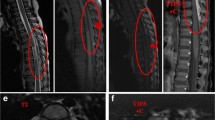Abstract
Proteus syndrome is a rare hamartomatous disorder involving macrodactyly, hemihypertrophy, and subcutaneous lymphangiomas; fewer than 25 cases have been reported worldwide. We report a case of a thoracic epidural lymphangiolipoma in a 5-year-old boy with Proteus syndrome. Computerized axial tomography (CT) of the thoracic spine revealed a left posterior mediastinal mass that extended into the spinal canal through adjacent neural foramina. No sign of spinal cord compression was observed despite the extensive volume of tumor within the spinal canal. Surgical debulking utilizing a T3-10 laminectomy resulted in gross total resection of the tumor. Microscopic examination of the surgical specimen revealed a lymphangiolipoma. No previous report of spinal cord involvement has been reported in this syndrome. A detailed discussion of the phenotypic features and probable mode of genetic transmission is included.
Similar content being viewed by others
References
Bannayan GA (1971) Lipomatosis, angiomatosis and macroencephalia. Arch Pathol 92:1–5
Clark RD, Donnai D, Rogers J, et al (1987) Proteus syndrome: an expanded phenotype. Am J Med Genet 27:99–117
Cohen MM (1988) Understanding Proteus syndrome, unmasking the elephant man, and stemming elephant fever. Neurofibromatosis 1:260–280
Costa T, Fitch N, Azouz EM (1985) Proteus syndrome: report of two cases with pelvic lipomatosis. Pediatrics 76:984–989
Goodship J, Redfearn D, Milligan D (1991) Transmission of Proteus syndrome from father to son? J Med Genet 28:781–785
Gorlin RJ, Meskin LK (1962) Congenital hemihypertrophy: review of the literature and report of a case with special emphasis on oral manifestations. J Pediatr 61:870–879
Graetz L (1928) Über einen Fall von sogenannter totaler halbseitiger Körperhypertrophie. Z Kinderheilkd 45:381–403
Happle R (1987) Lethal genes surviving by mosaicism: a possible explanation for sporadic birth defects involving the skin. J Am Acad Dermatol 16:899–906
Lezama DB, Buyse ML (1984) The Proteus syndrome: the emergence of an entity. J Clin Dysmorphol 2:10–13
Riccardi VM (1981) Von Recklinghausen neurofibromatosis. N Engl J Med 305:1617–1626
Temtamy SA, Pogers JG (1976) Macrodactyly, hemihypertrophy, and connective tissue nevi: report of a new syndrome and review of the literature. J Pediatr 89:924–927
Viljoen D, Pearn J, Beighton P (1984) Manifestations and natural history of idiopathic hemihypertrophy: a review of eleven cases. Clin Genet 26:81–86
Viljoen DL, Nelson MM, Jong G de, Beighton P (1987) Proteus syndrome in southern Africa: natural history and clinical manifestations in six individuals. Am J Med Genet 27:87–97
Weidmann HR, Burgio GR, Aldenhoff P, et al (1983) The Proteus syndrome. Eur J Pediatr 140:5–12
Author information
Authors and Affiliations
Rights and permissions
About this article
Cite this article
Whitley, J.M., Flannery, A.M. Lymphangiolipoma of the thoracic spine in a pediatric patient with Proteus syndrome. Child's Nerv Syst 12, 224–227 (1996). https://doi.org/10.1007/BF00301256
Received:
Issue Date:
DOI: https://doi.org/10.1007/BF00301256




